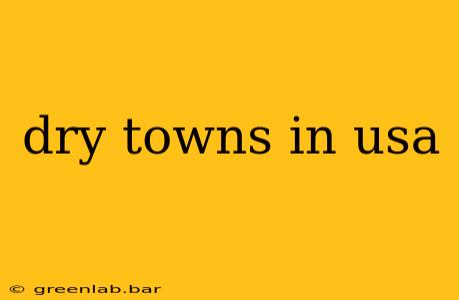The United States boasts a diverse landscape of alcohol regulations, with some areas maintaining "dry" status, meaning alcohol sales are significantly restricted or entirely prohibited. These dry counties, towns, and even entire states present a fascinating glimpse into American history and culture, reflecting a range of social, religious, and political influences. This guide delves into the complexities of dry towns in the USA, exploring their origins, prevalence, and the impact of these regulations on residents and visitors alike.
Understanding Different Levels of Dryness
Before diving into specific locations, it's crucial to understand the varying degrees of alcohol restrictions:
- Dry County/Town: The sale of alcohol is entirely prohibited. This often includes the production and distribution of alcoholic beverages.
- Wet County/Town: Alcohol sales are permitted, typically through licensed establishments like bars and liquor stores.
- Moist County/Town: This represents a middle ground. Alcohol sales might be permitted, but with restrictions like limited hours of operation or types of alcohol sold. For instance, beer and wine might be allowed, but hard liquor could be prohibited.
- Local Option: This allows individual counties or municipalities to decide whether to permit alcohol sales through local referendums or elections. This often results in a patchwork of wet and dry areas within a single state.
Historical Context of Dry Towns
The prevalence of dry towns in the USA is deeply rooted in the nation's history, particularly the temperance movement of the 19th and early 20th centuries. This movement championed abstinence from alcohol, leading to the passage of the 18th Amendment (Prohibition) in 1920. While Prohibition ultimately failed, its legacy continues in the lingering dry areas across the country. Many of these areas maintained their dry status even after the repeal of Prohibition in 1933, reflecting deeply held cultural and religious beliefs within specific communities.
Geographic Distribution of Dry Towns
Dry towns aren't uniformly distributed across the USA. They tend to be more prevalent in certain regions, often linked to strong religious traditions or historical precedents:
- The South: Many Southern states, particularly in rural areas, still have a significant number of dry counties. This is often attributed to the influence of conservative religious communities and historical social norms.
- The Midwest: Parts of the Midwest also feature dry counties, though their distribution is less concentrated than in the South.
- Rural Areas: Regardless of region, dry towns are overwhelmingly found in rural areas, where populations are smaller and local traditions hold more sway.
The Impact of Dryness: Benefits and Drawbacks
The existence of dry towns presents both advantages and disadvantages:
Potential Benefits:
- Reduced Alcohol-Related Problems: Proponents of dry status often point to lower rates of alcohol-related accidents, crime, and health issues.
- Stronger Community Bonds: Some argue that the absence of alcohol fosters stronger community ties and a more family-oriented atmosphere.
Potential Drawbacks:
- Loss of Revenue: Dry towns may miss out on tax revenue generated from alcohol sales, potentially hindering local economic development.
- Increased Tourism Challenges: The absence of alcohol can be a deterrent for some tourists, impacting the local hospitality industry.
- Enforcement Challenges: Maintaining a dry status can be challenging, with potential for illegal alcohol sales and consumption.
Finding Information on Specific Dry Towns
Locating specific dry towns requires research at the state and local level. Each state maintains its own alcohol regulations, and information can usually be found on the state's website or through contacting local government offices.
Conclusion: A Complex Legacy
Dry towns in the USA are a complex and multifaceted phenomenon. They represent a blend of historical, social, and religious factors, with ongoing debates about their benefits and drawbacks. Understanding the varying degrees of dryness and the regional differences is crucial for appreciating the diverse landscape of alcohol regulations across the nation. The future of dry towns remains uncertain, with ongoing shifts in public opinion and evolving social norms continuously shaping the legal landscape of alcohol consumption in the United States.

